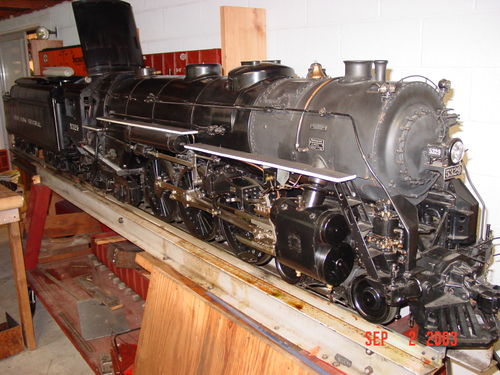Louis Arnold
1 inch Pacific
Father, Sons Construct Live Steam Locomoative
by Charles H. Kelly
News Staff Writer
"The Comberland News"
Cumberland, Maryland
14 December 1959

A toy train winding its way out of a tunnel toward the peaceful village in a Christmas tree yard fascinates young and old, but a Mt. Savage Road father and his two sons went steps farther and built a scale model live steam locomotive sturdy enough to haul three adults over a miniature railroad system in the yard of the home.
Over five years ago Louis Arnold, his son Richard, now 19, and William, about 16, obtained specifications from Irene Lewis, a California hobby concern, and blueprints from the Baltimore and Ohio Railroad Company.
They studied the B&O blueprints very carefully and scaled them down one inch to the foot and modeled the locomotive after one of the railroad's 5300 Pacific type 4-6-2's (four wheel lead truck, six driving wheels and two wheel trailer truck.)
Makes First Run
After going over the detailed specifications and plans time and again, materials were purchased and things began humming in the basement workshop of the Arnold residence.
The first run was made in March this year (1959) and periodically members of the family fire up the boiler and go for a ride over about 520 feet of track including some 100 feet from a switch to the basement "roundhouse" where a caboose is now under construction.
The system is located along the out edge of the Arnold property and the track is laid in the front and back yards. From rail to rail the track width is less than five inches.
Mr. Arnold, a machinist supervisor at the Kelly-Springfield Tire Company plant had plenty of railroading "know how" when he began constructing the steam engine and tender. He learned his machinist trade as an employee of the old Cumberland and Pennsylvania Railroad which had shops in Mt. Savage.
He completed his time in 1939 and worked for the C&P until 1943. His father, Daniel H. Arnold Sr., Frostburg, was a conductor for the C&P and Western Maryland Railway Company and worked out of Ridgeley just before he retired. Arnold's father=-in-law, the late John E. Barth, was wreck master of the C&P until the tune of his death.
In their childhood days, the two Arnold brothers became fascinated with O and S gauge model trains and later showed interest in live steam locomotives.
Added kindling to the fire of enthusiasm was noted when the boys went to Canada with their dad to compare ideas with other steam club enthusiasts. While across the border they saw other scale model trains in action.
The locomotive and tender are about eight feet in length overall and about ten inches wide. The flat car is lengthy enough to accommodate two passengers comfortably.
The flat car was built by Richard, a graduate of Mt. Savage High School who is now employed at Smith Engineering at LaVale. William worked along with his father and older brother.
The "engineer" who sits on the tender, merely lifts the roof of the locomotive and has easy access to the throttle and reverse gear of the engine which will "chug" along to speeds of seven miles per hour.
A steam gauge, water glass, feed water pump, steam whistle and headlight powered by batteries must be in perfect working condition at all times.
The locomotive's cooper boiler with its flue tubes is covered with a layer of asbestos and blue steel jacket which gives a sleek polished look to the engine.
Mr. Arnold said the tender is capable of holding about eight gallons of water. Two buckets of coal are ample fuel for a day's run, he added. Within eight hours about 24 gallons of water are usually necessary to furnish the necessary steam power.
Quarter-inch wide black iron rails were placed on pre-grooved cross ties which are about three inches apart on the ballast bed of the trackage. The ties, treated with creosote, were pre-cut with a power saw in the basement workshop. This required many hours of tedious work. To give you an idea, about 1,800 ties were turned out.
While laying out the course of the railroad system the Arnolds ran into dips in the terrain and filled them in with soil to assure a smooth ride along the rails.
They knocked out part of the wall of the foundation of their house in order to get the train into the roundhouse at the end of a day's run.
Grownups in the area, rather than youngsters, seemed to be more enthused about riding on the train, said Mr. Arnold, who read hobby books with stories on live-steam locomotives to get additional ideas on how to construct the locomotive, tender and flat car.
7.25 inch guage Hudson
Steampipe posted on Chaski.org:
- I aquired the loco from the original builder Rich Arnold who along with his father Louis, built this from 1987-89. Shortly after completion Louis passed on and the loco was put into storage having run only 4 times. I purchased it this past spring. It is an excellent runner, free steamer and good looker. Was wondering about the pedigree of the castings. By the way, it is 7.25 inch gauge.
